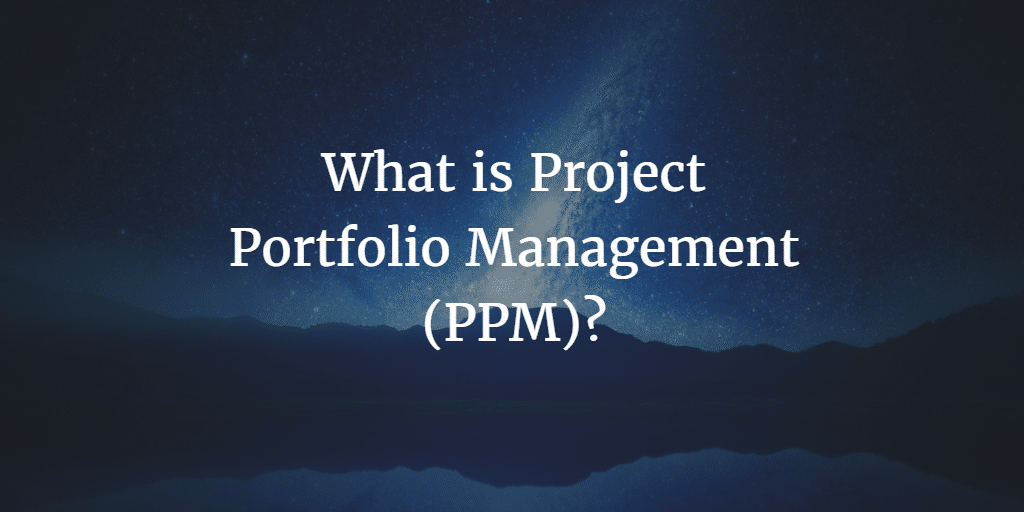What is PPM?
Project portfolio management (PPM) is an approach project management organizations (PMOs) and project managers use to prioritize, orchestrate and benefit from projects. Basically, it analyzes the potential return on a project. It does this by examining the amount of funds available for a project, potential turnaround times, expected outcomes and risk vs. reward ratios. This is all done by the project managers who are led by the project management office director, or a PPM group or project steering committee. They assess the prioritization, benefits and returns of each project to determine how an organization should invest their human resources and capital.
It doesn’t involve running the projects, but it does involve choosing the projects and their funding. Meeting an organization’s objectives and goals is the first qualifying criteria in the selection process, and if a project doesn’t meet this criteria, the PPM group will eliminate it from selection. PPM groups also examine the contingencies and interconnections among projects. Certain interconnections or relationships can affect the prioritization, funding, ranking and the number of projects in a portfolio. Additionally, PPM groups monitor projects in motion. Monitoring projects is necessary because poorly performing projects can negatively impact other projects.
How Projects Are Selected
Project portfolio management often relies on a project steering committee that helps decide how to best utilize funds on a project for a return on investment (ROI). The ROI is determined by the time value of money. Time value of money uses special formulas to determine the future or present value of a project based on certain criteria and projections. The most common time value of money formulas are: Present Value (PV) = Future Value (FV)/(1+i)n, Future Value = Present Value (1+i)n and Net Present Value.
- Present Value = Future Value: In this formula, “n” represents the number of time periods for a project and “I” represents the interest rate. This formula is used to calculate the projected value of a project versus the current value. For example, a project with an assumed future value of $7,500,000, a completion date of three years and an interest rate of six percent is represented in the formula as: PV= 7,500,000/(1+.06)3, which equals 6,297,144.62. So, if costs are projected to exceed $6,297,144.62, then this project is a bad investment that won’t provide an ROI.
- Future Value=Present Value: Once again, “n” represents the number of time periods for a project and “i” represents the interest rate. So, if a project has a turnaround time of two years, a budget of $375,000 and an interest rate of six percent, then it will be represented in the formula as FV= 375,000(1+.06)2, which equals 421,350.00. This means the project worth will increase from $375,000 to $421,350.00 in two years. A project with this type of growth will be profitable, and thus a worthy investment for a company. However, this formula is based on ordinary annuity and doesn’t take into account any perpetuities, periodic cash flow payments or increasing annuities.
- Net Present Value: Net Present Value calculates the present value for each year of a project then predicts the value of that project and the funds needed to complete it. The approach is used when it’s assumed that a project will have value and benefits that increase during the project time period. For example, benefits from a global organization planning to replace their manufacturing equipment in multiple locations over a three-year period will be felt almost immediately after each equipment replacement. These benefits will accumulate over time, becoming even more beneficial to the organization.
Time value of money (financial) is a major project selection method, but it’s certainly not the only one. Other project selection methods include: regulation considerations, the need of the project, productivity measures and efficiency. However, the financial component of project selection is often the focus of project portfolio management, because the PPM manages the budget for all projects.
The Need for the Organizational Maturity Model
An organizational maturity model defines how well a company can choose, manage and finish projects in its portfolio. The more a company grows, the more streamline the selection process becomes, which leads to a greater chance of success. Poor experience in choosing, prioritizing, monitoring and completing projects in the portfolio can result in a greater chance of inconsistencies in the portfolio.
However, the selection process can mature through experience, education and refinement. This is achieved through the use of the five levels of the PPM maturity model. Within the model, each level includes the attributes of the level below it and of course its own attributes. The five levels of this model are: Reactive, Emerging Discipline, Initial Integration, Effective Integration and Effective Innovation.
Reactive (Level One)
The attributes of this level include: Project cost estimates, a lack of project management tools and management directives based on urgent needs. This level typically includes newer companies and companies that are mostly entrepreneurial.
Emerging Discipline (Level Two)
This level includes: Prioritization of initialized projects, project managers who follow defined management processes for each project in the portfolio and a Project Management Office (PMO) that ensures all projects support an organizational strategy.
Initial Integration (Level Three)
At this level, a company has clearly defined project manager roles, a PMO, project steering committee and a PPM manager. Additionally, a company at this level has functional departments that work in collaboration with the organizational structure. It also uses a collection of projects within its project portfolio management.
Effective Integration (Level Four)
The attributes of this level include: An organization that leverages different knowledge sets from other aspects of the business, project portfolio modeling for ROI from the collection of projects, risk vs. reward analysis and the monitoring, tracking and forecasting of each project.
Effective Innovation (Level Five)
This is the highest level of PPM. At this level all project communication flows through an Enterprise PMO. Additionally, project managers are given a consistent stream of smaller projects with faster and more probable success rates. The PPM projects are also rolled out as quickly as possible.
Combined with each level of the maturity model, management is used to examine the probability of project success, potential adaptations to improve the flow of projects within the enterprise and perform lessons learned.
Tools Needed for Effective Project Portfolio Management
PPM is designed to help PMOs plan projects and predict project outcomes. Project portfolio management tools are used to help PMOs effectively plan projects using scenario analysis tools, spreadsheets and PPM software. However, there are many types of PPM tools. Organizations just have to keep in mind that the best tools:
- Offer user-friendly functionality and interfaces
- Provide robust analytics and reporting
- Accommodate PPM at the enterprise level (Level Five)
However, the best PPM tools and software will have many more benefits, including: a centralized communication, good reporting options and easy-to-use enterprise level software.
Centralized Communication
It’s common for organizations that take on multiple projects to employ team members who work remotely. But, this can make steady, effective communication almost impossible. Fortunately, there are online-accessible PPM tools that can help prevent and eliminate communication barriers by creating a streamlined, central communication hub. This central hub allows the team members to store, share and track feedback, data and files, connect and coordinate team members, answer questions and offer quicker solutions to problems, provide real-time employee and project status updates and quickly mine data that can be shared with stakeholders.
Good Reporting Options
For effective project planning, good reporting options are a must. Reports highlight active circumstances or projects that may impede the objectives and goals of an organization. This provides PMOs the perspective they need to predict what projects will require excessive resources and funding.
Effective reporting tools also allow PMOs to monitor every aspect of their company’s prospective projects, including risk/reward analysis, forecasting and budgeting. This will help a company see the possible impacts projects can have on one another and help them predict which projects will have a negative financial impact that may affect other business aspects. If a project falls behind, PMO can use PPM techniques to stifle the potential negative ripple effect. In other words, good reporting results in informed and factual PPM that can help an organization set expectations and guidelines for project performance.
Easy-to-Use Enterprise Level PPM Software
Enterprise equals one resource with various functionalities that can be used across the business structure. This effectively streamlines the entire project selection process. For this reason, most PPM tools are essentially enterprise software. Enterprise software decreases reliance on the running of several applications that may confuse workflow and increase overhead prices.
This software is also easy to use, meaning managers won’t need a tech degree to figure out how to run it. The software organizes information intuitively and incorporates simple functionality, including a “drag and drop” feature and more. So, essentially anyone can use it to make their project selection process simpler.
Manage the Risks of PPM
Risk is a normal part of business that can have a negative or positive outcome. Unfortunately, it’s a major part of project portfolio management, as every project has the potential to simply succeed or fail. The risk-reward ratio outlines the probability of success or failure for each investment a company makes.
It’s possible that projects with many unknown factors and high probability of failure can bring the greatest rewards and ROI if successful. On the other hand, lower risk projects can garner a smaller ROI and have little impact. This just means that it’s best for organizations to implement PPM that distributes their risk by investing in some high risk-high reward and some low risk-low impact projects. However, the entire PPM process can give an organization the foresight to identify risks and use proper measures to prevent them.
So, risks can be managed proactively while giving PPM groups what they need to estimate possible project delays and budgeting issues so that the proper measures can be put in place to mitigate these risks. However, there are three parts to this equation: Risk identification, risk analysis and risk mitigation or management.
Risk Identification
Risk identification is used to identify possible risky situations and events. After identification, each risk is analyzed for impact and probability through qualitative.
Risk Analysis
Basically, risk analysis examines the risk of taking on or not taking on a project. It assesses whether the quantitative value of doing a project outweighs the capital needed to fund the project. There are two types of risk analysis: qualitative and quantitative.
Qualitative analysis identifies risk events to determine if further analysis is needed. If further analysis is needed, then it will move to quantitative analysis. Quantitative analysis is used to quantify the probability of success or failure, as well as financial risk. Additionally, quantitative analysis determines project value.
Project value examines the productivity and expected efficiency of a project. For example, new hardware or software is expected to increase an organization’s efficiency, which will in turn increase its productivity.
Risk Mitigation
Risk mitigation or management includes: providing measurable risk-reward data, weighing team bandwidth against the amount of work to be done, determining design and bottleneck flaws at multiple levels and aligning each prospective project with organizational objectives and goals. Two tools help with this and give PMOs the ability to analyze, predict and balance risk. These tools are: Decision Tree Analysis and Monte Carlo Simulation.
- Decision Tree Analysis: A Decision Tree Analysis is needed when an organization is choosing between several projects to invest in. It measures the probability of a project’s success and determines the value of that success. Additionally, it determines the value of project failure or any negative amount or aspect of the project. The PPM uses these values to calculate the expected value of a project and compares that to the value of others. This will ensure the PPM makes the most intelligent financial decision based on the risk of investing.
- Monte Carlo Simulation: Monte Carlo Simulation uses computer software to determine possible outcomes based on a combination of factors. It does this by simulating positive and negative factors. This will uncover extreme outcomes as well as the most likely outcomes of certain project decisions and changes.
Take Smart Risks
Taking risks in business is even more notable than the risks themselves. In fact, it can be seen as a cornerstone of business. However, risk taking should always involve smart decision making. This means approaching the risk-reward factor intelligently, which is where PPM comes in. Project portfolio management helps organization’s plan projects and predict their outcomes. It does this in several ways, including highlighting questions like:
- Does the company have current or past projects that can be used as models for new ones?
- Does the company have the funds and resources available to start a project?
- Will proposed projects meet the objectives of the company?
- What current projects might hinder the completion of a new project? Will a new project hinder the completion of current projects?
- Are stakeholder expectations realistic? Is compromise possible? Where is compromise possible? Are both sides willing and able to compromise?
All in all, PPM allows an organization to examine every detail of every prospective project and the tasks, timelines, goals, resources and budgets associated with those projects. In depth analysis can also help determine what risks offer the greatest rewards. Key indicators help weigh project costs against returns, specifically ROI, which in turn is used to determine if a project is a worthy investment. This helps create replicable, efficient and fluid workflow as well as optimal performance on each project.






